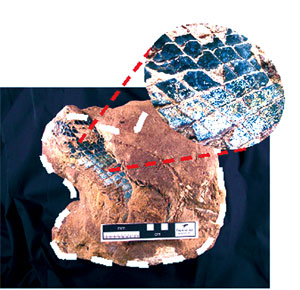Hunting expedition nets scales from gar fish in dinosaur footprint
One of the most remarkable instances of fossil preservation ever seen at the College of Eastern Utah’s Prehistoric Museum arrived in Price recently in a most unusual package. The fossil itself, a gar pike named Lepisosteus, is similar to gar fish today, but is much older, dating back to the Cretaceous Period. While the durable diamond scales of these freshwater fish are common in fossil localities of the West, a fairly complete three-dimensional body fossil is a rare find, said Jeff Barlett, director of collections and research at the museum ?

One of the most remarkable instances of fossil preservation ever seen at the College of Eastern Utah’s Prehistoric Museum arrived in Price recently in a most unusual package. The fossil itself, a gar pike named Lepisosteus, is similar to gar fish today, but is much older, dating back to the Cretaceous Period. While the durable diamond scales of these freshwater fish are common in fossil localities of the West, a fairly complete three-dimensional body fossil is a rare find, said Jeff Barlett, director of collections and research at the museum ?
What is even more unusual is this unfortunate fish’s mode of preservation: the gar was found intact in the mold of a dinosaur footprint.
The find in the Book Cliffs Mountains (east of Price) was made by Christopher Davis of Wellington. Davis was hunting last fall when he stumbled upon the find. He thought the impression was that of a reptile.
His dad was friends with Clark Warren and brought the fossil over to Warren’s house to look at it. Warren immediately knew the print was from a dinosaur. He could not tell if the dinosaur had stepped on a fish or another dinosaur. Upon further investigation, Warren decided the image was from a giant gar fish, that was swimming in the Green River Formation millions of years ago. He figured the fish was in the seaway and a dinosaur stepped on it, forever recording history. He said gar fish today are in the Mississippi River and in Florida.
The fish scales look like black diamonds and are shiny to look at.
Museum director Reese Barrick and Barlett believe the fossil may have some bone and skull matter in it. When the snow melts, Davis plans to take Warren to the area where he found the fossil.
“I want to look at the sandstone formation and that will tell us what time frame or era the dinosaur and fish lived in,” Warren said. At the times the dinosaurs roamed this area, it was part of a giant sea way with semitropical, arid temperatures.
The dinosaur footprint is part of the trackway made by an unknown three-toed dinosaur, possibly a duckbill herbivore. The astonishing co-occurrence of a rare body fossil with a dinosaur track is unique as far as we know, Barlett added.
Humorous speculation about clumsy dinosaurs stepping on fish aside, the puzzling print with its fish find have stumped scientists as to how exactly they came to be associated, but are destined for description in one of the leading paleontological journals.




